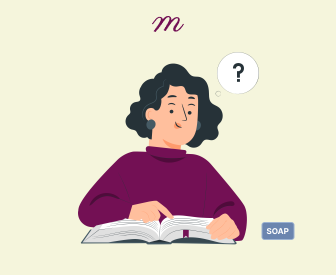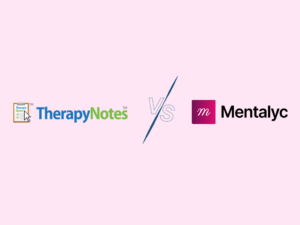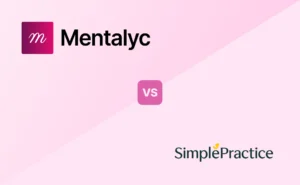SOAP notes are a widely adopted method of progress note documentation used by mental health professionals to write down and organize information clearly, concisely, and systematically. The SOAP method offers a structured framework to document therapy sessions, track client progress, and support clinical decision-making. This method fosters a holistic view of the client while focusing on specific therapeutic goals.
What is A SOAP Note?
The SOAP method aims to create a clear, concise, and systematic way of recording client information, ensuring that clinicians (regardless of specialty) can quickly understand a client’s status and the rationale behind their treatment plan. The Objective section captures all the measurable, observable, and quantifiable data obtained during a session. Unlike the Subjective section, which details the client’s self-reported experiences, feelings, and perceptions, the Objective part includes therapist observations and standardized assessment scores or measurable outcomes. Therapists may include the following information in the Objective section.
Behavioral Observations. Include nuanced nonverbal cues that clients exhibit in sessions. Detailed descriptions of the client’s appearance can provide insights into self-care and mental state. For example, significant changes in hygiene might indicate depression or a psychotic episode. Excessive or insufficient eye contact can reveal anxiety, social discomfort, or other underlying issues. A client’s slumped or rigid posture can reflect their emotional state or level of confidence, while excessive fidgeting or a lack of movement might indicate nervousness or depression. Recording these observations offers a comprehensive view of the client’s nonverbal communication and helps formulate a more accurate mental health assessment.
Mental Status Examination (MSE). The MSE is a cornerstone of psychological assessment, providing a snapshot of a client’s current cognitive and emotional functioning. The therapist notes the client’s emotions and what is observed during the session. For example, a client might report feeling “fine,” but their affect might be flat or incongruent with their stated mood. Thought processes and content are assessed for coherence, speed, and whether they include delusions or hallucinations. Speech patterns, including the rate, volume, and pressure of speech, can indicate various psychological conditions. Cognition is evaluated through the client’s orientation to time, place, person, attention span, and executive functions. Short- and long-term memory is also assessed, providing insight into cognitive impairments.

New! Transfer your notes to EHR with a single click. No more copy-pasting.
Psychometric Assessments. Psychometric assessments are standardized tools that measure various psychological functions and states. These tools offer quantifiable data that can be used to support clinical observations and diagnoses. For example, depression inventories such as the Beck Depression Inventory (BDI) or anxiety scales like the Hamilton Anxiety Rating Scale provide specific scores that help in assessing the severity of a client’s condition. Assessments can guide treatment planning and offer a baseline for tracking progress. It’s important to interpret these results within the clinical picture, considering the client’s history, presenting problems, and other assessment data.
Physiological Data. Although traditionally more aligned with medical practices, physiological data can be highly relevant in mental health settings, especially given the mind-body connection. For example, observations or reports of sleep patterns can be critical in diagnosing and treating disorders like mood disorders, anxiety, or insomnia. Changes in appetite or weight might signal eating disorders. Psychosomatic symptoms, where psychological factors influence physical symptoms, underscore the importance of considering physiological data in a comprehensive psychological assessment. This holistic approach ensures that treatment plans address all elements of a client’s well-being.
Incorporating detailed observations and data across these areas enhances the quality of psychological care. It provides a multidimensional view of the client that informs more accurate diagnoses, treatment plans, and effective interventions, ultimately supporting better mental health outcomes.
How to Write the Objective in SOAP Notes
Writing the Objective section involves careful observation and documentation of factual, measurable, and observable data regarding the client’s current state. This section lacks interpretations or subjective opinions, focusing instead on the therapist’s direct observations and any test results. Here’s how to capture the information in the Objective section.
- Behavioral Observations are crucial for understanding a client’s non-verbal communication and any unexpressed signs or symptoms.
- Appearance: Note the client’s physical appearance, including clothing, grooming, and hygiene. For example, “The client arrived wearing soiled clothing and appeared disheveled.”
- Demeanor and Behavior: Describe the client’s general behavior, mood, and interaction style during the session. Mention whether the client is cooperative, resistant, passive, or aggressive. For instance, “The client was restless and frequently fidgeted during the session.”
- Posture and Motor Activity: Document posture and motor activity. This might include agitation, tremors, lethargy, or psychomotor issues. For example, “The client displayed a slumped posture and moved sluggishly.”
- Facial Expressions and Eye Contact: Note the client’s facial expressions and eye contact throughout the session. This could range from “blank” or “flat” expressions to “tearful” and from “steady” eye contact to “avoidant.”
2. Mental Status Examination (MSE) is a structured way of observing and describing a client’s mental state.
- Mood and Affect: Describe the client’s reported mood (“The client reports feeling hopeless”) and the observed affect (“Affect is flat and does not change in response to different topics of conversation”).
- Thought Processes and Content: Note the client’s rate of speech, clarity of thought, and any unusual thought patterns or content, such as delusions or hallucinations. For example, “Speech is rapid and tangential, with themes of persecution in thought content.”
- Cognition: Assess the client’s orientation (to time, place, and person), attention, concentration, and memory. This might include specific tests or questions asked during the session.
- Speech Patterns: Document speech characteristics, including the rate, volume, and any disturbances in the flow or rhythm of speech.
3. Psychometric Assessments may be used. If so, objectively summarize the results.
- Include the name of the test or screening tool administered, such as the Beck Depression Inventory or the Hamilton Anxiety Scale.
- Report the scores obtained and interpret the scores based on test norms. For example, “Client scored 28 on the Beck Depression Inventory, indicating severe depression.”
4. Physiological Data, if relevant, includes any physiological observations or reported symptoms that may have psychological implications.
- Document reported changes in sleep patterns, weight, appetite, or energy levels. For example, “Client reports insomnia and decreased appetite over the past two weeks.”
- Note any psychosomatic symptoms or physical complaints, ensuring these are clearly described without assuming psychological origin.
Follow these best practices to ensure the Objective section is well-written and comprehensive:
- Be concise and specific, avoiding generalizations.
- Use objective language, focusing on what was observed rather than interpretations.
- Ensure confidentiality and privacy by avoiding overly personal details irrelevant to treatment.
- Regularly review and update your note-taking skills to reflect best practices and any new guidelines.
Writing the Objective section requires a balance of detailed observation and clinical judgment. This ensures the information is accurate and relevant to the client’s treatment plan.
Subjective vs. Objective sections of SOAP notes
The Subjective section is client-centered, focusing on clients’ reports of their experiences, symptoms, feelings, and perceptions. This section is the narrative part of the progress note where the client’s voice is prioritized. In contrast, the Objective section is clinician-centered, highlighting the therapist’s observations, measurements, and assessments. This section is factual and devoid of interpretations. It provides a clear, unbiased view of the client’s status.
Three Objective SOAP Note Examples
Here are three detailed examples of depression, anxiety, and post-traumatic stress disorder (PTSD) to clarify how mental health professionals write the objective section in SOAP notes. Each case provides a view of the information that makes up the Objective section, including Behavioral Observations, Mental Status Examination (MSE), Psychometric Assessments, and Physiological Data.
Depression:
Behavioral Observations: The client presented with noticeably disheveled attire, indicating a lack of personal care. Eye contact was minimal, suggesting possible avoidance or discomfort in social interactions. The client’s posture was slumped, and movements were observed to be significantly slowed. Speech was characterized as soft and limited to monosyllabic responses, pointing toward possible lethargy or disinterest in engagement.
Mental Status Examination (MSE): The client’s mood was consistently described as “low,” their affect appeared blunted, indicative of diminished emotional responsiveness. Thought processes, while linear, exhibited a marked slowness. There were no indications of delusional thinking, suggesting that thought content did not include irrational beliefs. The client was fully oriented to time, place, and person, with short-term memory remaining intact. However, the client reported significant difficulties with concentration, a common cognitive complaint in depression.
Psychometric Assessments: The individual’s responses on the Beck Depression Inventory resulted in a score of 28, which falls into the severe depression category. This quantitative data reinforces the clinical observations and self-reported symptoms, providing a more comprehensive understanding of the client’s condition.
Anxiety:
Behavioral Observations: The client exhibited restlessness, frequent fidgeting, and an apparent inability to remain seated for extended periods. Eye contact was made intermittently, potentially reflecting discomfort in the therapeutic setting or underlying nervousness. Speech patterns were rapid and occasionally tangential, further underscoring the client’s anxious state.
Mental Status Examination (MSE): The observed mood was anxious, with an affect that matched the reported feelings of anxiety. Thought processes were coherent but exhibited a faster pace than typically expected, suggesting racing thoughts. The MSE did not reveal any hallucinations or delusional thoughts, and cognitive functions were deemed intact, showcasing the client’s ability to maintain a grasp on reality despite their symptoms.
Psychometric Assessments: The Generalized Anxiety Disorder 7 (GAD-7) scale was administered, yielding a score of 21. This score suggests a severe level of anxiety, corroborating the observed and reported symptoms and highlighting the need for targeted interventions.
Post-Traumatic Stress Disorder (PTSD):
Behavioral Observations: The client’s demeanor was tense, with observable hypervigilance as evidenced by frequent scanning of the surroundings. A pronounced startle response was noted at minimal noises, indicative of heightened arousal. Eye contact was sparingly offered.
Mental Status Examination (MSE): The mood conveyed was fearful, with a notably restricted affect limiting the emotional range. Speech was coherent but guarded, suggesting a cautious approach to sharing information. Symptoms of hyperarousal and avoidance were evident. The cognitive assessment showed no signs of dissociation during the session, indicating the client remained present and engaged despite heightened arousal.
Psychometric Assessments: The PTSD Checklist (PCL) was used to quantify symptom severity.
These examples underscore the importance of thorough Objective documentation in SOAP notes, integrating observations, standardized assessments, and careful examination to inform diagnosis and guide treatment planning.
The Bottom Line
So overall the objective section of SOAP notes plays a really important role in mental health documentation, providing a totally unbiased and measurable record of a client’s status. It uses vital signs, examination findings, and laboratory results, offering a concrete basis for diagnosis and treatment planning. This section bridges the subjective symptoms reported by clients with the clinician’s assessment and proposed treatment plan, ensuring a holistic approach to client care. By maintaining a clear, factual account of observations, Mental healthcare professionals can track progress, adjust interventions, and ensure continuity of care, thereby optimizing client outcomes.
Why other mental health professionals love Mentalyc

“It’s so quick and easy to do notes now … I used to stay late two hours to finish my notes. Now it’s a breeze.”
Licensed Professional Counselor

“By the end of the day, usually by the end of the session, I have my documentation done. I have a thorough, comprehensive note … It’s just saving me hours every week.”
CDCII

“It takes me less than 5 minutes to complete notes … it’s a huge time saver, a huge stress reliever.”
Licensed Marriage and Family Therapist

“Having Mentalyc take away some of the work from me has allowed me to be more present when I’m in session with clients … it took a lot of pressure off.”
LPC






